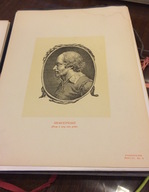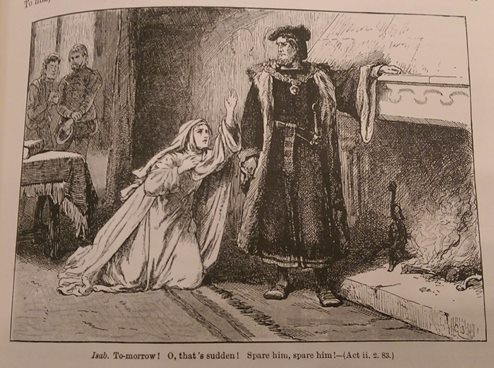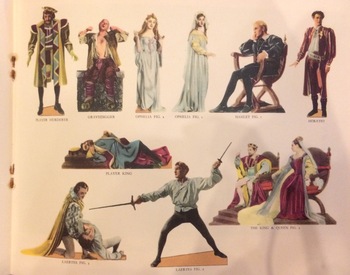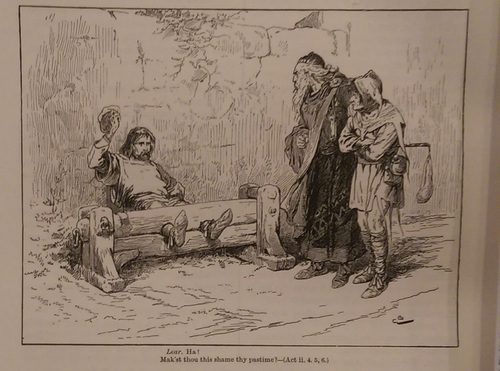Court Masques and the Illustrated Component of Performace
Normal
0
false
false
false
EN-US
JA
X-NONE
/* Style Definitions */
table.MsoNormalTable
{mso-style-name:”Table Normal”;
mso-tstyle-rowband-size:0;
mso-tstyle-colband-size:0;
mso-style-noshow:yes;
mso-style-priority:99;
mso-style-parent:””;
mso-padding-alt:0in 5.4pt 0in 5.4pt;
mso-para-margin:0in;
mso-para-margin-bottom:.0001pt;
mso-pagination:widow-orphan;
font-size:12.0pt;
font-family:”Times New Roman”;
mso-bidi-font-family:”Times New Roman”;
mso-bidi-theme-font:minor-bidi;}
I’ve been thinking and reading a lot about court masques
this week, specifically about the style Ben Jonson worked to form. For those of
you who don’t know, court masques were theatrical productions for British
nobles containing music, dance, songs, and poetry in varying degrees. In
addition to the dancing, performance, and revels, they included elaborate set
designs and special effects.
Now, I know Jonson isn’t Shakespeare, but they were
contemporaries, and in many ways, the masques were like plays of the time.
Though the two inhabited different spheres, private versus public, and dealt
with different notions of fiction and reality within the space of the
performance, both may be read as literature. By that, I mean that the play
remained isolated, whereas the masque could blur the line between fiction and
reality because many times, nobles themselves would act in the performances.
Other times, the masquers would dance with members of the audience, uniting the
actors and observers in an in-between space of active entertainment. Such an
amalgamation between fictional characters and real life persons sets the tone
for further combinations of different realities.
Why, you ask, have I been looking at something that is
definitively not Shakespeare? Well,
it’s because I’ve been finding several items in the Special Collections that
fall into the category of masque using Shakespeare’s plots and/or characters. And
on the note of combining different realities, one in particular performs a sort
of literary mash-up or crossover, making characters from Macbeth and Henry IV
interact with Greek Gods, such as Apollo and Minerva, and even muses, like
Comedy and Tragedy.
Not only does this masque mix the different worlds of
Shakespeare’s plays, it also combines them with classical mythology. Not only
does this fall into the masque tradition of using Classical figures to augment
the performance, but it sets up Shakespeare as worthy of such comparison. In a
way, the masque suggests that Shakespeare’s characters are as powerful and
everlasting as the Greco-Roman gods.
The court masque, in a way, lives on through printed
editions of Shakespeare’s plays by drawing on the concepts of spectacle,
design, and illustration as accompaniments to the text of a performance. A few
examples show colorful scenes from The
Tempest and Macbeth.
Both place the characters in a fictional world, choosing
instead to make the scenes they depict works of literature rather than theatre.
Through these pieces (including the masques), we see a form of genre
manipulation taking place, showing the versatility of Shakespeare’s works.
That’s just another reason to appreciate Shakespeare. And for further genre manipulation, watch The Lion King (a version of Hamlet), or even take a gander at a graphic novel based on the Bard and his characters (called Kill Shakespeare, and you can find it here through the library).
Hamlet: A Fellow of Infinite Jest
This week’s SpeCol (Special Collections) Scoop comes from the Philbrick Collection, which is a massive collection of drama-related media donated to the school by the Philbrick family. One of these boxes is a collection of sets for toy theaters, which were somewhat like dollhouses with removable backgrounds and paper dolls. From what I can tell, toy theater companies chose short plays, gave plot synopses, usually in one act, provided the backgrounds for each scene, and gave the characters in various necessary positions for the play.
The Fool
The Unscripted Kiss
The Third and Final SURP/CCEP Researcher Chimes In
Normal
0
false
false
false
EN-US
JA
X-NONE
/* Style Definitions */
table.MsoNormalTable
{mso-style-name:”Table Normal”;
mso-tstyle-rowband-size:0;
mso-tstyle-colband-size:0;
mso-style-noshow:yes;
mso-style-priority:99;
mso-style-parent:””;
mso-padding-alt:0in 5.4pt 0in 5.4pt;
mso-para-margin:0in;
mso-para-margin-bottom:.0001pt;
mso-pagination:widow-orphan;
font-size:12.0pt;
font-family:”Times New Roman”;
mso-bidi-font-family:”Times New Roman”;
mso-bidi-theme-font:minor-bidi;}
Hi all!
I’m Alana, a rising
Senior, English major, and Writing Fellow at Pomona College. Just two weeks
ago, I returned home to sunny SoCal after 6 months in Cambridge, UK. Currently,
I’m part-time (but that may change; we’ll see). Anyway, in addition to curating
exhibits and working in CCEPs with Emma and Pieter, I’m also going to use this
library time to get started on my thesis examining magical language in
Shakespeare’s plays.
When I’ve told people
that I’ll be writing about Shakespeare (and will possibly be pursuing a
Master’s in it as well), I’ve gotten two reactions. 1) That’s awesome! or 2)
Ew, Shakespeare is no fun. Well, part of what my aim for this blog is to make
the latter group see is that Shakespeare is fun. For example,
take a look at this picture of an actor portraying Richard III.
Just look at his facial
expression and body position and try to tell me that he’s boring. There’s so much sass.
More that just this
picture, though, I’ve come across a few cool illustrations while searching for
a direction for my research. One (see below) is from The Tempest,
one of the magic plays and one of Shakespeare’s last plays. In this one,
Prospero commands certain natural forces and spirits of this abandoned island,
and we can see the extent of his power in this image from a 1871 decorative
edition of Shakespeare’s works.
This same edition
contains this image (see below), featuring the Bard himself (again, look at
that body position and tell me this is serious). As the creator, Shakespeare
sits with some of his characters, including the transformed Bottom (he’s the
donkey) from A Midsummer Night’s Dream. The banner at the top asserts something we
have seen come true: Shakespeare has endured for all time (so far).
There’s a whimsical feel
to this picture and places Shakespeare in the same plane as his characters,
possibly suggesting that they exist in the same world. Considering how writer had
come to be “our immortal Shakespeare,” it is no surprise to see him placed in
the same plane as his characters (from the Proem of F.G. Waldron’s The Virgin Queen: A Drama in 5 Acts;
Attempted as a Sequel to Shakespeare’s Tempest. 1797).
Along these lines, I
found a masque called Shakespeare’s
Jubilee (1769) which places characters from plays like Macbeth, A Midsummer Night’s
Dream, and The Tempest in one
common setting, one which the bard eventually enters. Not only does this masque
reflect trends of people imitating his works, it represents a fictionalization
of the writer into an idea subject to creative manipulation rather than a
static historical figure.
(The Bard, right there in the masque with characters he created.)
I don’t know about you,
but I think that’s pretty cool. If you do, too, please stick around for more
posts to come. It’s nice to make your Internet acquaintance!
–Alana
Experiencing tragedy in King Lear and Luther’s writings
“The play [King
Lear],” writes philosopher Stanley Cavell in his essay on the play, ‘The
Avoidance of Love’, “can be said to be Christian–not because it shows us
redemption–it does not; but because it throws our redemption into question, and leaves it up to us.” What
is Cavell referring to, exactly? We see Lear take the Gods’ names in vain, to
no avail; it is Lear, not the Gods, that is responsible for throwing his world
into chaos through his cruelty to his subjects and the rejection of his
daughter Cordelia, who ultimately is killed as a result. Placing ownership of
wrongdoing in Lear’s hands, and giving Lear the opportunity, if he so chooses,
to be redeemed from this, is what one might view as a Christian setup.
I said one might;
but another might find the label Christian here quite problematic. If it was
truly in Lear’s hands to choose, one way or the other, to redeem his kingdom or
to perish, we must essentially ‘blame’ Lear for having chosen the former.
Cavell asks: “And what room is there for blame? Is he to blame for being human?
For being subject to a cosmic anxiety and to fantasies which enclose him from
prefect compassion? Certainly blame is inappropriate, for certainly I do not
claim to know what else Lear might
do.” Which is to say that it is rather difficult to look at this play, and its
characterization of Lear’s suffering, and say that it was his ‘fault’ he acted
in this way, or that audience members would have acted differently. (As Cavell
notes, we are confident that we know what Lear should have done when Cordelia did not ‘heave her heart into her
mouth.’ But that does not mean that we would have acted more prudently than
he.)
“And yet,” Cavell writes, I cannot deny that my pain at
Lear’s actions is not overcome by my knowledge of suffering.” The inability to
hold Lear accountable coupled with the “pain at Lear’s actions” leads to what
Cavell calls “unplaceable blame…like blaming heaven.”
What I would like to do is play around with this in
theological terms. If we were to view
Lear’s failure as a theological illustration (which Cavell believes it ultimately
is not, despite the above discussion of redemption), what would we see? If we
agree that it is difficult to really blame Lear for his actions in light of his
suffering, but he nonetheless suffers for them greatly, we can view Lear’s
suffering as parallel to an important theological concept of the time, the
draconian determinism of Martin Luther’s writings. In 1525, Luther wrote The Bondage of the Will, in response to
criticism from Desiderius Erasmus: “with regard to things pertaining to
salvation and damnation, man has no free will, but is a captive, a bond-slave,
either to the will of God, or to the will of Satan.” I think here, too, our
reaction might be a feeling of “unplaceable blame.” Erasmus asked in 1524: “What
will be the origin of merits where there is perpetual necessity and where there
never was free will?” And without a method for assessing ‘merit,’ how can God
justly damn his subjects eternally? And in the same vein, how can we (or the
universe) damn Lear for actions that seem beyond his power to avoid?
Cavell writes of this dilemma in Lear that the feeling of
“unplaceable blame” is “not inappropriate as an experience of tragedy, of what
it is for which tragedy provides catharsis.” I think we could say the same of
the story Luther writes for mankind; God and demons damning or saving people,
outside their own control, sounds indeed a bit like dramatic tragedy.
As noted in Cavell’s essay, some have conceived of Lear,
when he is cast out from his daughter’s house and faces the storm, has arrived
at “the naked human condition.” Cavell wants to say that he is something
different–he is not “simply a man,” but is in fact a scapegoat for viewers. And
as Lear tells us the world is a “stage of fools,” Cavell says Lear insists that
it is routinely human to make scapegoats of one another, to throw around blame
(as one might do to Lear). Perhaps it is precisely when we don’t do this, when
blame is put aside, that we see tragedy–in Lear
or in Luther’s vision of predestined salvation.
Queen Mab Intervenes/How Much Artistic Liberty is Too Much?
I was browsing special collections two days ago and I found Romeo and Juliet Travestie: or, The Cup of Cold Poison, an 1873 version of the play with a surprising adaptation; this version is a burlesque, in one act. There are books that tell the stories of Shakespeare’s plays in condensed form, with modern language, and I have heard of plays (particularly Nahum Tate’s King Lear) that replace the ends of the plays with happier versions, or more family-friendly words and ideas (Thomas Bowdler’s The Family Shakespeare).
Even though this adaptation inspired disdain (in me), I think its existence is symptomatic of the fact that, at least as I see it, Shakespeare is no longer “just a playwright,” and hasn’t been “just a playwright” for a long time. The plays no longer mean the same thing they may have at the time of their creation; thinking about any of his works comes with the baggage of his name, what it means as a student or an actor to read/perform, any adaptations or even pop references one may have heard, and even the difficulty that can arise in trying to read such old English. His work is more of a jumping-off point than the end of the road. It inspires people, either to push harder with research, thought, or creative outpourings. Setting aside this burlesque, which still inspires in me a bit of hoity-toity attitude, I think this sort of movement is impossible to avoid, and, in many ways, is a really important piece of change and growth.
Welcome, Emma/Faces of Shakespeare
Hello, all.



An introduction and some thoughts on “Measure for Measure”
Hello!

















